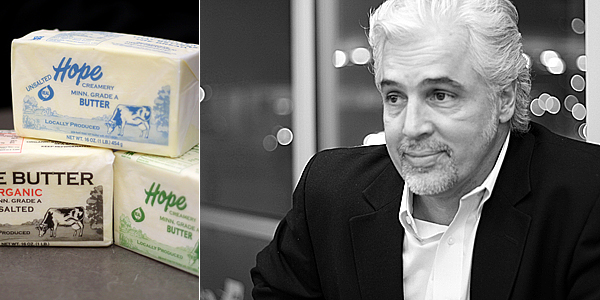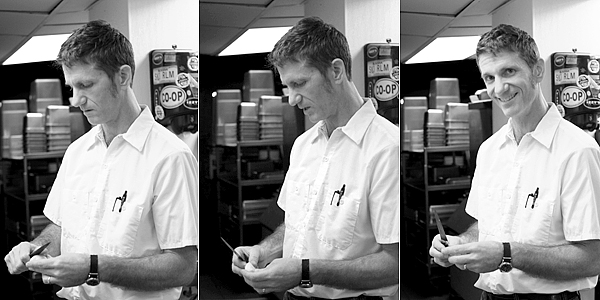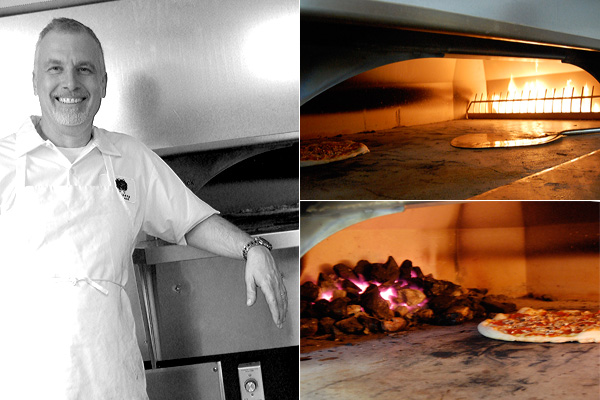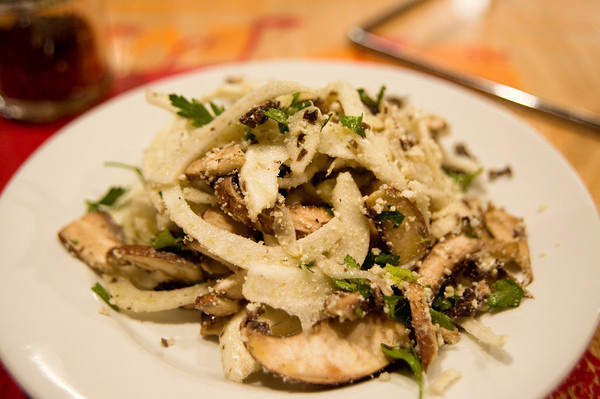
As we approach the end of 2009, in a joyful mood and looking for things to be thankful for and to celebrate, we have an embarrassment of riches to consider. While assembling our first annual Silver Whisk Awards, the Heavy Table staff learned that there are far more worthy contenders than one could possibly hope for, and that all of our finalists had stories that were worth telling.
In the end, however, we settled on three winners. These are the Upper Midwestern food institutions and people who most caught our imagination, most inspired us, and made us most grateful for the privilege of eating their fine foods. Here we present our 2009 choices for Best Purveyor, Best Chef, and Best New Establishment.

Best Purveyor: HOPE CREAMERY
Try telling Victor Mrotz, owner of Hope Creamery, that his butter has had a big impact on the Twin Cities, and he’ll tell you that’s not the point.
“Our intention was to make this old creamery viable so it continues,” he says. “It was just one of those rickety old things that needs to be protected. But I like to say that we did it so we wouldn’t have to pay our health insurance out of our farm check book. It was either get another job or start a business — if I just made enough money for health insurance, I’d be happy.”
That modesty belies his dedication to the creamery and the quality of its butter and his strong commitment to the local food community — all of which has made Hope Creamery the 2009 Heavy Table Silver Whisk Award Winner for Best Purveyor.
In 2001, when the Mrotz bought it, Hope Creamery — which had been operating in Hope, MN for about 100 years – employed 2 people and sold about 30,000 pounds of salted butter a year to a few local grocers. He made deliveries in an old green Volvo 240 station wagon he inherited from his wife. “I’d load it up in the early morning,” he says. “Put a quilt over the cases of butter in the back of the car and take off!”
“The first time I came up to the Twin Cities, I had four cases and I brought two home,” he adds. “Pretty soon it got to the point where we had to take the seats out of the car so we could make deliveries. Then I bought I truck and I thought, ‘I’m never going to get the truck paid for, I’m never gonna fill it.’ Six months later we had to buy another one, a bigger one.”
In part, timing enabled the creamery to grow so quickly: Organic, locally sourced food was just starting to catch on, and few if any of the local creameries were producing their own butter.
It was Chef Julie Boor of Lucia’s restaurant who first came knocking at Hope Creamery. “She and I kind of went around and around,” says Mrotz. “She kept asking, ‘Are you really making butter?’”
Boor’s persistence was well founded. In her quest for local butter, she discovered several small dairies that claimed to be making their own butter, but when she’d visit, it would become clear that they were in fact sending cream out to be processed in the AMPI Butter Plant in New Ulm, Minnesota. “I told her, ‘You come down here, and we’ll put you to work.’ And she did.”
 Boor loved the butter and invited Mrotz to bring some up to Lucia Watson, who told him she’d buy whatever he could make — with the caveat that she wanted it unsalted. “I went home kind of long-faced,” he says, “but when I told Gene [Kruckeberg, a butter maker, who has been with Hope Creamery since 1964], he said, ‘We used to make a lot of unsalted butter.’ So we made some and took it to Lucia. She said, ‘When can I get it?’ And that was our leg into the business.”
Boor loved the butter and invited Mrotz to bring some up to Lucia Watson, who told him she’d buy whatever he could make — with the caveat that she wanted it unsalted. “I went home kind of long-faced,” he says, “but when I told Gene [Kruckeberg, a butter maker, who has been with Hope Creamery since 1964], he said, ‘We used to make a lot of unsalted butter.’ So we made some and took it to Lucia. She said, ‘When can I get it?’ And that was our leg into the business.”
In eight years, Mrotz has grown the creamery to 11 employees, who produce and deliver 300,000 pounds of butter a year to restaurants and grocery stores around the Twin Cities.
As notable as it is that Watson gave the butter a chance, that anecdote also demonstrates Mrotz’s early and ongoing dedication to customers. Another example: When Lunds and Byerly’s approached Hope Creamery, they initially asked Mrotz to use one of their distributors. When he balked, they suggested that, if he wanted to deliver directly, perhaps he could add a few more products to his delivery. Today, Mrotz delivers locally produced milk, eggs, and meat, in addition to his butter. That has turned out to be helpful for his smaller customers, too — and for local producers like Hill and Vale Farms, which would otherwise have a difficult time getting its meat up to the Twin Cities.
Although customer service and growth are important, when we looked at the Best Purveyor nominees, Hope Creamery rose to the top for its ability to produce a smooth, sweet, and distinctly creamy butter that — according to local chefs and bakers — not only stands up to premium national brands, but also to the heavy hitting imports.
What makes the butter so good? Its ingredients and the way it’s made.
Mrotz gets hormone-free milk for his conventional butters from Hastings Cooperative Creamery in Hastings, MN, which provides milk from several small Minnesota farms. The organic cream comes from Pride of Main Street Dairy in Sauk Centre, MN. The latter is especially well known for the flavor of its cold-separated milk. “If you are going to have milk and cookies, that’s the milk you want,“ Mrotz says. “It tastes better. People always say, ‘Man, this milk tastes good — this is how milk should taste.’”
Hope Creamery makes butter once a week, producing about 5,000 pounds in two batches. It’s a surprisingly simple process — though obviously not without its nuances — and that may be the secret.
The milk is vat pasteurized for an entire day. Then any ingredients are added (well water, salt, occasionally chive) and the entire contents are swirled in a single, 900-gallon motorized batch churn that rolls the cream around until it is forms globs of butter the size of a 50-cent piece. Once the buttermilk is drained off, the curds of butter are rinsed and tumbled in cold water, removing the milk solids — the flotsam that separates from clarified butter, eventually producing a cleaner butter.
Finally, the water is drained off and the butter is churned until it turns into a huge, 2,500-pound block of butter, rolling in the drum.
After employees test the fat content and flavor and make any adjustments, the butter is hand packed into a butter wrapping machine in 30-pound chunks, pressed into a mold, and wrapped in paper — pretty much the same papers that have been used at the creamery for the last 50 years or so; it’s likely they were chosen out of a label catalog in the heyday of creameries.
The finished product is hand stacked on a cart and wheeled into a 12- by 14-foot walk-in, where it is restacked. “I call it hand-made butter because we pick it up and stack it about eight times during the process of making it,” says Mrotz.
That process takes about four hours and produces butter that is anywhere from 80 percent butterfat for conventional butters to 85 percent butterfat for the unsalted high-fat butter — the stuff that makes bakers and chefs gaga for Hope Creamery.
According to Solveig Tofte, head baker at Turtle Bread Company, a butter with higher fat content lends itself well to laminating doughs — croissants, danish, puff pastry — because it’s more pliable than the regular stuff. “You want a high plasticity on your laminating butters so they can stretch out — as opposed to cracking — and create nice, thin, even layers in your pastries, “ she says. “Higher fat butters also create more tender baked goods, help cakes gain more volume, and generally are very tasty.”
“I did a side-by-side comparison with regular (AMPI) and Hope butter on the pound cake many years ago and the difference was night and day,” she adds. “The Hope pound cake had more volume, and the sweet cream flavor of the butter was the high note — not the sugar, which I appreciated the most.”
That’s what we all like best: A butter we can eat on a cracker, a butter so good it’s almost like cheese. Speaking of which, Mrotz hinted that future plans for Hope Creamery might include cheese and possibly a version of the high-fat butter packaged for retail consumption.
In the meantime, he seems a bit awed that the creamery has done as well as it has. “What amazes me is that people are willing to take invest the energy to understand what the products are and where they come from,” he says. “People could easily go to Cub and get 26 pork chops for three bucks, but instead they take the time to work at work at shopping — and we were fortunate or smart enough to get in front of it.”
— Susan Pagani

Best Chef: MIKE PHILLIPS, THE CRAFTSMAN
The 2009 Best Chef winner of the Silver Whisk awards is Chef Mike Phillips of The Craftsman, in recognition of his unwavering support of local food and his thoughtful approach to creating truly handmade cuisine.
Raised in the Midwest, Phillips worked in several kitchens before opening Chet’s Taverna in 1998, a St. Paul neighborhood restaurant focused on local cuisine. Six years ago he moved to The Craftsman, where he continues to be a quiet but influential force in the local food scene.
Although known for many talents, Phillips is perhaps best known for his artisan approach to crafting food. At the now-defunct Chet’s, this meant going so far as to hand-roll his own couscous. “It’s painstaking,” says Phillips of his desire to hand-craft food. As he peels onions to make sauerkraut, he explains further, “It’s a common joke around my house. The kids will want something to eat, like potato chips, and I’ll be like — we can make those. I don’t know why, I’m just interested that if it’s possible to do, that I’d like to try to make it.”
At The Craftsman, the charcuterie plate exemplifies this artisan approach. Although the plate’s features change regularly, you can guarantee that each item on the plate is house-made, from the mustard to the pickled vegetables to the cured meats and pates.
While he may be best known for his charcuterie, Phillips feels his cooking is best represented when he can utilize a whole animal in cooking, as in his ragùs. He explains that buying whole animals, rather than just the prime pieces, means the restaurant also receives the livers, hearts, and other parts of the animals. “So we have, usually, other parts and we make ragùs using all those other parts. We always start off with a part of our charcuterie, which is guanciale — a pork cheek that gives it this really great velvety mouth-feel that really makes the sauce. I think that’s one of my favorite things, for sure, is the ragù for pasta.”
Although Phillips deserves our Silver Whisk Best Chef title for his excellence in creating artisan cuisine, his longstanding dedication to supporting local food stands out as equally worthy of recognition.
Reflecting on the evolution of the local food movement in the Twin Cities, Phillips is amazed at the support that local producers have seen in this turnkey year. A supporter of local foods, Phillips jumped in this year to work with other chefs, such as Corner Table’s Scott Pampuch, in organizing Tour de Farm’s debut.
“When we sat down to figure out the Tour de Farm stuff, we were thinking about what we should charge and will anyone come. And the first week, most of it sold out and we were like, Wow. I was just amazed by the support — it’s a great thing to see. It’s been a lot of hard work. When we had Chet’s and were [cooking locally], I just wondered how many people really cared or whether they were just there to eat. And I think the number has changed. I think that maybe 20 percent of those people who were coming in then really cared and I think that number has gone over 50 percent. I’m just glad to see that it makes sense to people.”
With ambition to continue supporting local food, Phillips sees himself getting even more involved. “I just hope to keep having some influence — in policy, perhaps.” Although he’s quick to dismiss “lobbying” to describe his involvement, he acknowledges the importance of educating decision makers from the producers’ and farmers’ point of view. “I’m not going to run for office or anything, but it would be nice to be involved.”
Although we hope community support of local food continues to grow, we know that even if it doesn’t, Phillips is in it to go the distance. When asked how the change in support and popularity of local food has influenced him, he is quick to reply: “I think I’m just reinforced. I wasn’t going to change anyway.”
— Katie Cannon

Best New Establishment: BLACK SHEEP COAL FIRED PIZZA
What happens when you apply Michelin-starred restaurant experience to straightforward American pizza? The result is Black Sheep Coal Fired Pizza, winner of the 2009 Heavy Table Silver Whisk award for best new establishment.
Prior to Black Sheep’s opening, your closest options for real coal-fired pizza were probably in New York or Boston, at places like Grimaldi’s, Santarpio’s, or Patsy’s (the last of these was a direct inspiration for Black Sheep founder Jordan Smith). But with the opening of Smith’s Warehouse District pizzeria, the Minnesotan eating scene gained a new facet that’s worth bragging up.
Smith’s restaurant background is dizzyingly extensive — “this is the 23rd restaurant I’ve opened,” he told Heavy Table writer Kelly Carlin. His resume — which includes stints in Paris, Milan, and the French Alps, plus a year and a half at Le Gavroche, a Michelin-starred London restaurant — plays itself out on Black Sheep’s menu, in its kitchen, and in its dining room.
The restaurant is unfussy, unpretentious, and pared down to the essentials. Smith’s got a reductive eye, and the fruit of this is a focused, gem-polished coal-fired pizzeria of the highest caliber.
“I didn’t want to do a place that seemed fancy,” says Smith. “If you’re a pepperoni and mushroom guy, I want you to come in and get a pepperoni and mushroom, and for it to be the best one you ever had…. as opposed to ‘fancier.’ But at the same time, we buy the absolute best ingredients we can find or make them, or whatever it takes to make our pizza what it is.”
The lack of veneer is a welcome twist to a place that could have just as easily been a nest of hipster-driven fussiness. One of the qualities that sets Black Sheep apart is that it is self-evidently obsessed with being excellent, rather than looking excellent. The menu is simple, the prices are affordable, the atmosphere is casual — if you weren’t paying attention, you’d think you were in just another nice, new neighborhood pizza place.
Black Sheep dazzles, however, with its flavors. The toppings speak of hand-crafted love and top-notch ingredients. The crust is a minor miracle — a perfect blend of chewy and crisp, popping with enough wholesome flavor to balance the sauce and cheese without overwhelming it.
“We worked for about six months really trying to dial in on the flavor profile,” Smith says of his crust. “If you take one of our dough balls and just proof it and bake it, it’ll look like a really hearty sourdough… it takes a two-day proofing process to develop the flavors you get in our crust. You can tell by the size of the air cells.”
The coal-fired oven adds a critical twist to the final product.
“What’s great about coal,” says Smith, “is that it’s a much drier fuel than natural gas or wood, because it’s a rock. It makes for a super dry oven, which makes for a crispier crust.”
What goes on the pizzas, of course, needs to live up to the rest of the pie. The quality and provenance of Smith’s ingredients speak to the place as a whole.
“We make our sausage in house, we make the meatballs — the cheese is from Wisconsin,” says Smith. “I try to buy local ingredients where it’s applicable, and do business with local vendors so that the dollars stay in our local economy. Sometimes it gets overlooked how critical that piece is, in the buy-local movement. I’m not going to get olive oil from Minnesota. But I can buy my olive oil from a local company as opposed to a multinational company like US Foodservice or Sysco.”

We’ve noted in this magazine that the restaurant’s salads are beyond reproach — among the most austerely thoughtful and ravishingly delicious versions in the Twin Cities, a case of going far beyond the requirements for a pizza place. They play with subtle flavor combinations and unusual vegetables — they make unexpected statements and compel exploration. Even dedicated carnivores may be surprised by how pleasant they are to wolf down.
“I’m really proud of our salads,” Smith says. “We have such a limited menu that I think it’s really critical that everything we do is really delicious. A lot of work and care go into the salads. I want to do the best job I possibly can, and that means you pay attention to all the details — not just the obvious ones.”
Although Smith occupies the limelight, he gives much of the credit for Black Sheep’s success thus far to his wife.
“I wouldn’t be doing this without my wife Colleen [Doran],” he says. “She and I are partners on this. The force she brings to customer service, design, site selection — it’s monumental. We wouldn’t be here having this fun if it weren’t for her. That’s really a critical piece.”
“Something that always seems to get dropped — well, people love chefs, but sure, you can be a great cook — but does that really translate to having a great business plan? We’ve all been to restaurants where the food is great and everything else is… meh. Here we want everything to be great — we have to have great service, we have to have a great looking room — everything. She’s really the brains of the operation.”
Smith and Doran are already looking to the future, planning to open for lunch in January and scouting for a possible second location. Undoubtedly, any expansion will be premised on the idea that the original Black Sheep was founded upon: satisfying a simple desire for good food.
“One of the things that has always motivated me as a cook is that I love to eat,” says Smith. “Honestly, why can’t I have the pizza I love right here? And that struck us as a good idea.”
— Written by James Norton, Reported by Kelly Carlin

Wow, you blew it on Best New Establishment. You are just wrong on the salads. Pizza is good but not the best thing to come to the Twin Cities this year.
Sorry, but Heavy Table made a big mistake on this one. Either of your other two options were more worthy.
Wahhhhhh Wahhhhhhhh. The Heavy Table blew it because they didn’t pick MY favorite pretentious little spot forBest New Establishment. Cry me a river. Why don’t you get your own blog and order up some cheese with your whine THEN you get to pick Best New Establishment.
Would the Twin Cities be ready for an night of offal at The Craftsman? I hope they do it someday (unless they already did it and I missed it).
I am yet to eat at Black Sheep, but really want to in the very near future. I’ve enjoyed Tosca on two separate occasions and have enjoyed Adam’s food for a few years now, so I’m glad to see his place was in the running. Can Chef Shack be considered a “New” establishment? I thought they’d been around prior to this year. Full Disclosure: I am a HUGE Chef Shack fan.
Congrats to our friend Mike, an extremely talented chef and a swell guy, to boot. Hope Creamery butter is a worthy winner, too–the only butter we use, in our home cooking and our Real Bread baking. One thing Mike and Hope Creamery have in common is that both go about producing their exceptional products with little hype or self-promotion. That makes it all the more fitting that they get this kind of recognition. I haven’t had the Black Sheep pizza yet, but I’m eager to try it.
Thanks to The Heavy Table for shining the light on the good guys.
Brett
In defense of black sheep, it is exactly the sort of restaurant that are truly the bread and butter of a vibrant food scene. It is not french laundry, but rather it is simple food done well. And the salads are truly excellent.
Great pick!
Congrats to Jordan Smith, Colleen Doran, and everyone at Black Sheep who have given us not just the best new establishment, but quite possibly the best food experience, dollar for dollar, in the Twin Cities. The pies coming out of that oven are transcendental, and those fantastic salads and meatballs, not to mention the concise but excellent beer & wine list and attentive service, round out the experience at Black Sheep.
Sorry Carla, but you’re dead wrong. Enjoy your Domino’s.
Jeff,
I was thinking the same exact thing. I would definitely be in as I am a fan of what Chris Consentino is doing at Incanto in SF. Phillips already makes incredible charcuterie…Offal has to be his next step.
Good call on Black Sheep! :)
Black Sheep is good. Fun atmosphere, good service, tasty wine, good salads. But I have to agree with Carla – it is an mind-blowingly good. I lived three blocks away and went regularly, so I can say this with certainty.
And BTW Keith, just because someone doesn’t agree with you doesn’t mean they like crap food. It just means they don’t agree with you. Lighten up.
I guess we’ll have to agree to disagree that Black Sheep is an mind-blowingly good. I live all the way down in South Minneapolis and I go there regularly too, because it’s awesome.
And I wasn’t dissing Domino’s. I was saying I really, sincerely hope she enjoyed her Cali chicken bacon ranch pizza and Cinna-stix.
Congratulations to all the whisk winners and nominees,
I have to give some Big Big UPs to my man Mikey P. This guy does it right and does it every night. He’s been sticking to his guns since the beginning and still has a hand on the holster. It takes a certain type of person to get excited about the huge phallic hunks of meat hanging in a locker next to their desk.
Congratulations to one of the nicest guys in the industry.